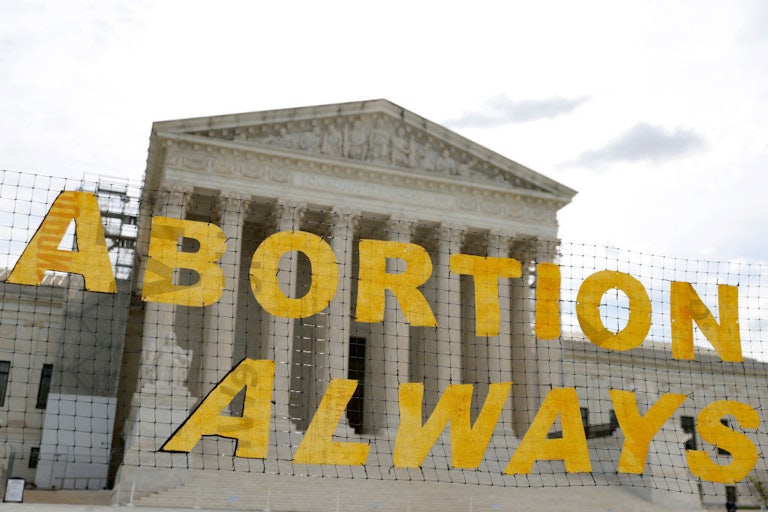The Hot New Down-Ballot Races: State Supreme Court Seats
With the end of nationwide abortion rights, money and attention is pouring into state-level high court races.

Ever since the Supreme Court overturned Roe v. Wade two years ago, races for state Supreme Courts have garnered increased attention and money, becoming the new battleground for abortion rights and access. This year will be no different, as 33 states will hold elections for seats on their high courts.
“Dobbs was a watershed moment in state judicial politics,” said Michael Milov-Cordoba, counsel in the Brennan Center’s Judiciary Program, referring to the decision that overturned Roe. “As it became clear to advocates and to the public that abortion access in their state would be determined by decisions made by state Supreme Courts, there became increased attention from both the public and national interest groups to win races.”
Although many state Supreme Court races are technically nonpartisan, the courts themselves tend to have ideological wings, much like federal courts where nominees are chosen by the president and confirmed by the Senate. Party apparatuses and outside organizations also get involved, pouring money into the races. The Brennan Center found that 2021 and 2022 were record-breaking years in this regard: More than $100 million was spent in judicial races in 17 states. The high-profile Wisconsin race in 2023, won by Judge Janet Protasiewicz, saw upward of $50 million in spending.
But 2024 may set a new record. This Monday, two liberal organizations announced that they have linked up to invest $5 million in high court races in key states. The National Democratic Redistricting Committee, which is dedicated to ensuring congressional and legislative maps are competitive for Democrats, and Planned Parenthood Votes, the political arm of the organization, will fund digital and canvassing operations to get out the vote for candidates in Arizona, Michigan, Montana, North Carolina, Ohio, and Texas.
Jenny Lawson, executive director at Planned Parenthood Votes, said that they are specifically targeting “places where Republicans have tried to stack the court with radical antidemocratic justices.” The joint campaign plans to partner with community advocacy groups to tailor their strategies to local needs. “What’s important to voters is that it is clear to voters the biases and hyperpartisanship of judges that we need to reject,” she said. “Our job will be to inform the voters of the choices in front of them.”
Three of those states—North Carolina, Ohio, and Texas—have explicitly partisan elections. North Carolina and Ohio have moved from nonpartisan to partisan elections in the past 10 years, with significant ramifications. Since North Carolina Republicans gained control of the state Supreme Court in 2022, the justices have reversed course on major issues such as gerrymandering and racial discrimination. (Other states have seen their legislatures attempt to limit the power of the high court, including Montana, where Republicans have been frustrated by the court’s protection of abortion rights and blocking restrictive voting laws.)
Michigan and Ohio also have a particularly narrow ideological divide on their state Supreme Courts, meaning that the upcoming elections could flip the courts’ partisan majorities. Abortion “looms large” in the Ohio race, Milov-Cordoba said, because the court will be evaluating the right to an abortion recently enshrined in the state Constitution by voters last year. Meanwhile, Democrats are defending their majority in Michigan.
For Ohio, Planned Parenthood Votes will emphasize to voters how the governor and state legislature attempted to stymie a ballot initiative to protect abortion and how the state Supreme Court permitted deliberately complicated wording for the measure on the ballot. “They’re watching their voices and votes being taken away,” Lawson said, adding that PPV’s campaign will argue that shifting the ideological leaning of the court would protect those “voices and votes.” In Michigan, however, the focus will be on how a “favorable” court has protected abortion access.
Even in states where justices are chosen by the governor or a judicial committee, voters have the chance to weigh in on those choices with “retention” elections. In Arizona, two of the justices who joined in the controversial decision to reinstate a nineteenth-century law banning nearly all abortions are now facing retention. Although Arizonans have never booted anyone from their high court, the two justices’ future may hinge on how important abortion is to voters on Election Day.
For Arizona and the other states, the goal is to ensure voters “know that these races are critical to these freedoms, and that they are making informed choices based on the positions of these justices,” Lawson said. “Our goal here isn’t partisanship, it’s about fundamental fairness.”
Vibe check: Immigration redux
Each week, I provide an update on the vibes surrounding a particular policy or political development. This week: Senate Democrats press forward with a doomed immigration bill … again.
Eons ago, in February, a bipartisan bill that would have overhauled immigration, asylum, and border policy failed on the Senate floor. Although it was the fruit of months of negotiation by GOP Senator James Lankford, Democratic Senator Chris Murphy, and independent Senator Kyrsten Sinema, congressional Republicans turned their backs on the bill amid opposition from former President Donald Trump.
Immigration has long been a topic that favors Republicans, and in a hotly contested election year with control of the White House and Congress up for grabs, it may be more useful to GOP candidates, especially Trump, to have the topic as a political cudgel. (House Republicans passed their own hard-line legislation, which they insist is the correct and only path to their stated goal of securing the border.)
Nevertheless, Democrats are trying to flip the switch on Republicans, hammering them for opposing the bipartisan legislation. On Thursday, the Senate will vote once more to proceed on the bill—even though it will not garner sufficient GOP support to succeed. Senate Minority Leader Mitch McConnell scoffed on Tuesday that the upcoming vote was “just a gimmick, a way to try to convince the American people that they’re concerned about this.”
It will also be opposed by Lankford, who has condemned the exercise as opportunistic. “This is not trying to accomplish anything, this is about messaging. This is trying to hurt Republicans,” Lankford told reporters this week, complaining about the lack of outreach from Democrats on trying to find a new consensus bill. “There’s been no legwork. There’s been no attempt to try to bring people back together again to try to figure out how we resolve this.”
But politically speaking, it doesn’t matter if Lankford votes for it, or any other Republican, or even most Democrats. Really, it just needs to make a small subsection of Democrats look like they’re “tough on the border”: those incumbents who face difficult reelection battles in red and swing states. Take Senator Jon Tester, who’s up for reelection in Montana. When I was in the state last month, I saw a TV ad by Tester’s campaign hailing his support for shutting down the southern border and his willingness to work with Republicans on legislation to expel certain migrants. Other vulnerable Democrats include Senators Sherrod Brown of Ohio, Bob Casey of Pennsylvania, and Jacky Rosen of Nevada.
There is a question of timeliness; Lankford wondered why Democrats were putting the bill to a vote the week before Memorial Day, when Americans aren’t likely to be paying attention to what the Senate is doing. Senate Majority Leader Chuck Schumer insisted there was no political calculation behind the vote now.
“Everything the Republicans do has no chance of passing. So who’s more serious about fixing the border? We are. And I think the public will understand that,” Schumer said.
Murphy, who helped negotiate the bill, echoed that argument. “I don’t know if there’s magic to voting this week, but if you think something’s important, you don’t give up on it just because you fail once,” Murphy said. “I think it would be insincere for us to say we care about passing the bipartisan border bill and not try to bring it up a second time.”
A second time, a third, a fourth—there’s no real political downside to continuing to vote on the measure between now and November. All the more chances to counter the narrative that Democrats are soft on immigration. If immigration is an important issue this year—and polling points to that being the case—those vulnerable Democrats will want to tout their voting for a bipartisan bill that Republicans rejected as often as they can.
But Tester rejected the implication that there would be electoral benefits to his voting on the immigration measure this week, telling Punchbowl News that was “bullshit.”
What I’m reading
The lynching that sent my family north, by Ko Bragg in The Atlantic
Is ‘Love Is Blind’ a toxic workplace? by Emily Nussbaum in The New Yorker
How free school meals went mainstream, by Susan Shain in The New York Times
He came to L.A. 3 months ago with his young family. A ride on a Metro bus led to his death, by Rachel Uranga in the Los Angeles Times
Inside Georgia’s crusade to make bail unpayable, by Nia T. Evans in Mother Jones
How a Southern Baptist minister came to lead an LGBTQ-affirming church, by Monica Hesse in The Washington Post
She wanted an abortion. Her only option was driving to Mexico, by Shefali Luthra in The 19th. (Side note: This is an excerpt from Shefali’s new book, Undue Burden: Life and Death Decisions in Post-Roe America, out this week! Shefali is a great abortion reporter, and this is a nuanced and deeply reported book.)
Pet of the week
Want to have your pet included at the bottom of the next newsletter? Email me: gsegers@tnr.com
This week’s featured pet is Ziggy, a 4-year-old, six and a half pound Yorkshire terrier submitted by Iris Lopez. As evident in this photo, Ziggy hurt his foot while playing “monkey in the middle,” his favorite game (aside from playing fetch in the snow). Iris assures us that his foot is fine now.

















